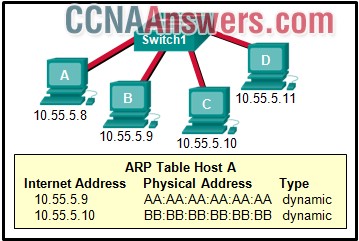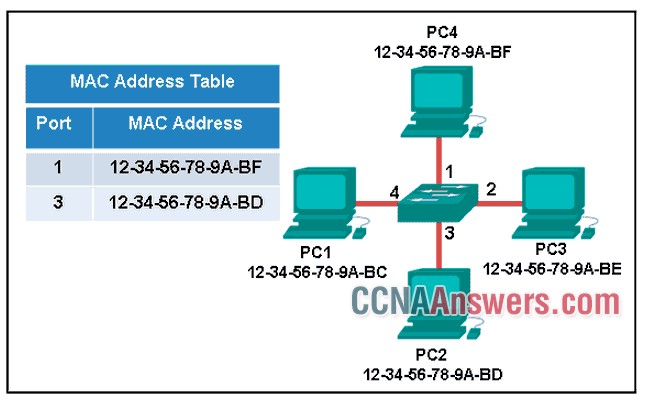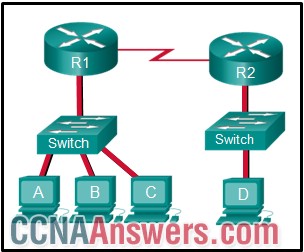CCNA 1 Chapter 5 V6.0 Answers
1. Refer to the exhibit. A switch with a default configuration connects four hosts. The ARP table for host A is shown. What happens when host A wants to send an IP packet to host D?

Host A sends out a broadcast of FF:FF:FF:FF:FF:FF. Every other host connected to the switch receives the broadcast and host D responds with its MAC address.
Host D sends an ARP request to host A.
Host A sends out the packet to the switch. The switch sends the packet only to the host D, which in turn responds.
Host A sends an ARP request to the MAC address of host D.
2. Which destination address is used in an ARP request frame?
0.0.0.0
255.255.255.255
FFFF.FFFF.FFFF
01-00-5E-00-AA-23
127.0.0.1
3. What statement describes Ethernet?
It defines the most common LAN type in the world.
It connects multiple sites such as routers located in different countries.
It defines a standard model used to describe how networking works.
It is the required Layer 1 and 2 standard for Internet communication.
4. What are two potential network problems that can result from ARP operation? (Choose two.)
Large numbers of ARP request broadcasts could cause the host MAC address table to overflow and prevent the host from communicating on the network.
Network attackers could manipulate MAC address and IP address mappings in ARP messages with the intent of intercepting network traffic.
On large networks with low bandwidth, multiple ARP broadcasts could cause data communication delays.
Manually configuring static ARP associations could facilitate ARP poisoning or MAC address spoofing.
Multiple ARP replies result in the switch MAC address table containing entries that match the MAC addresses of hosts that are connected to the relevant switch port.
5. What addressing information is recorded by a switch to build its MAC address table?
the destination Layer 2 address of outgoing frames
the source Layer 2 address of incoming frames
the source Layer 3 address of outgoing packets
the destination Layer 3 address of incoming packets
6. What are the two sizes (minimum and maximum) of an Ethernet frame? (Choose two.)
64 bytes
56 bytes
128 bytes
1518 bytes
1024 bytes
7. Fill in the blank.
On a Cisco switch, port-based memory buffering is used to buffer frames in queues linked to specific incoming and outgoing ports.
8. What happens to runt frames received by a Cisco Ethernet switch?
The frame is sent to the default gateway.
The frame is dropped.
The frame is broadcast to all other devices on the same network.
The frame is returned to the originating network device.
9. Which two statements describe features or functions of the logical link control sublayer in Ethernet standards? (Choose two.)
The LLC sublayer is responsible for the placement and retrieval of frames on and off the media.
Logical link control is specified in the IEEE 802.3 standard.
The data link layer uses LLC to communicate with the upper layers of the protocol suite.
Logical link control is implemented in software.
The LLC sublayer adds a header and a trailer to the data.
10. Refer to the exhibit. The exhibit shows a small switched network and the contents of the MAC address table of the switch. PC1 has sent a frame addressed to PC3. What will the switch do with the frame?

The switch will forward the frame to all ports.
The switch will discard the frame.
The switch will forward the frame to all ports except port 4.
The switch will forward the frame only to port 2.
The switch will forward the frame only to ports 1 and 3.
11. The ARP table in a switch maps which two types of address together?
Layer 4 address to a Layer 2 address
Layer 2 address to a Layer 4 address
Layer 3 address to a Layer 2 address
Layer 3 address to a Layer 4 address
12. Which statement describes the treatment of ARP requests on the local link?
They are dropped by all switches on the local network.
They are received and processed only by the target device.
They must be forwarded by all routers on the local network.
They are received and processed by every device on the local network.
13. What is auto-MDIX?
a type of Cisco switch
a type of port on a Cisco switch
an Ethernet connector type
a feature that detects Ethernet cable type
14. Match the characteristic to the forwarding method. (Not all options are used.)

cut-through (A) -> low latency (A)
cut-through (B) -> may forward runt frames (B)
cut-through (C) -> begins forwarding when the destination address is received (C)
store-and-forward (D) -> always stores the entire frame (D)
store-and-forward (E) -> checks the CRC before forwarding (E)
store-and-forward (F) -> checks the frame length before forwarding (F)
15. True or False?
When a device is sending data to another device on a remote network, the Ethernet frame is sent to the MAC address of the default gateway.
True
False
16. Refer to the exhibit. The switches are in their default configuration. Host A needs to communicate with host D, but host A does not have the MAC address for its default gateway. Which network hosts will receive the ARP request sent by host A?

only router R1
only hosts A, B, C, and D
only hosts A, B, and C
only hosts B, C, and router R1
only hosts B and C
only host D
17. Fill in the blank.
A collision fragment, also known as a _RUNT_ frame, is a frame of fewer than 64 bytes in length.
18. Which statement is true about MAC addresses?
The first three bytes are used by the vendor assigned OUI.
A NIC only needs a MAC address if connected to a WAN.
The ISO is responsible for MAC addresses regulations.
MAC addresses are implemented by software.
19. Which switching method uses the CRC value in a frame?
store-and-forward
fast-forward
cut-through
fragment-free
20. What statement describes a characteristic of MAC addresses?
They must be globally unique.
They have a 32-bit binary value.
They are only routable within the private network.
They are added as part of a Layer 3 PDU.
21. Fill in the blank.
ARP _spoofing_ is a technique that is used to send fake ARP messages to other hosts in the LAN. The aim is to associate IP addresses to the wrong MAC addresses.
22. Refer to the exhibit. PC1 issues an ARP request because it needs to send a packet to PC2. In this scenario, what will happen next?

PC2 will send an ARP reply with its MAC address.
RT1 will send an ARP reply with its Fa0/0 MAC address.
SW1 will send an ARP reply with its Fa0/1 MAC address.
RT1 will send an ARP reply with the PC2 MAC address.
SW1 will send an ARP reply with the PC2 MAC address.


Leave a Reply